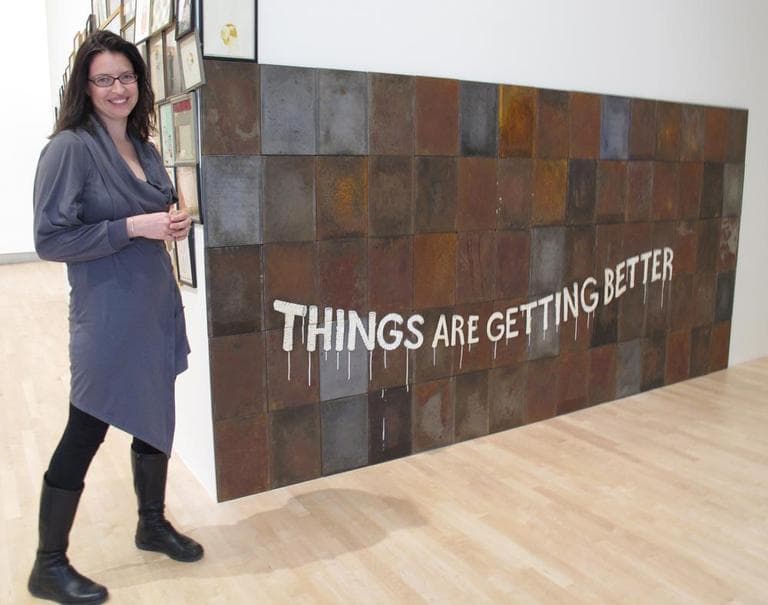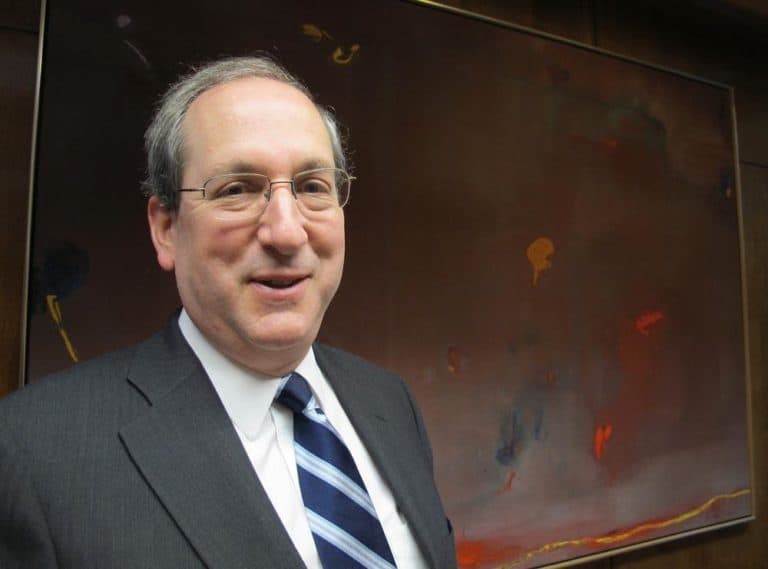Advertisement
After Controversy, Brandeis Brings Back The Rose Art Museum
ResumeAfter a firestorm of controversy, the Rose Art Museum at Brandeis University is reemerging with a $1.7 million facelift for its 50th anniversary. The building, upgraded by the local architecture firm Bruner/Cott, looks great — but it hasn't been easy for the school to move past all of the bad press and bad feelings that followed its proposal to sell its stellar art collection and close the Rose. That news enraged faculty, alumni and the larger art world in 2009.
World-famous pop artist James Rosenquist is one of the many who has harbored bad feelings. He pulled out of a 2010 show at the Rose in response to the plan. But this week he returned for the museum's re-opening.
Rosenquist’s large-scale piece, “Two 1959 People,” is part of the Rose’s original trove of 1960s masterworks — and now it’s back on the renovated gallery's freshly painted walls. The 78-year-old artist put his face right up to the canvas so he could examine how it’s fared over time, and then admitted he’s relieved it wasn’t sold.
"Well I think Marcel Duchamp said, 'I put the best I can in my work and it either has a life of its own or it doesn’t,' " Rosenquist said, evoking the French iconoclast, "and I’ve had a lot of experiences with my work having a life of its own.

"My 'F-111' painting that I sold for $25,000 was eventually bought by the Museum of Modern Art for $5 million," he said with a head shake and a laugh, "so I know all about that stuff! And it’s nice to have my painting exhibited here."
Rosenquist’s painting hangs alongside pieces by his contemporaries in a new exhibition called “Art at the Origin.” It was curated by Dabney Hailey, the museum’s first director of academic programs. She was hired in 2010, and says the Rose’s first curator, Sam Hunter, made some very smart acquisitions between 1961 to 1965.
"Every one of them is an iconic work, really. The James Rosenquist, Lichtenstein, Rauschenberg, James Brooks, Alex Katz..." and Andy Warhol, Hailey said. And the list goes on.
Taken together, the pieces capture a milestone moment in the history of American art, according to Brandeis alumnus Adam Weinberg. He came back to check out the new Rose, too. In the gallery he told Rosenquist how he remembers the artist's piece well.
"I spent an awful lot of time sitting on the floor staring at your painting," he said, adding, " I did!" when the artist chuckled at his wistful musing.
Weinberg graduated from Brandeis in 1977. Today he’s the director of the Whitney Museum of American Art in New York.
"It’s one thing to look at slides in a dark room as an art historian, it’s another thing to actually see the pigment, to see the color, to see the texture," Weinberg said. "You know, looking at Jim Rosenquist’s painting here, and the ability to have access to high quality artworks, I think is critical for any student who’s learning art history."
And that’s one of the reasons Weinberg was heartbroken — and horrified — two years ago, when works like Rosenquist’s seemed destined for the auction block.
In recession-strapped 2009, Brandeis's endowment plummeted. That’s when former President Jehuda Reinharz announced plans to monetize the collection and shut down the Rose.

"A university is about education, and a museum is about preserving artworks, those were my two fundamental concerns," Weinberg said. "People gave the artworks as a trust to the university, and it saddened me that a trust had been broken."
Repairing that rift was paramount to Fred Lawrence, who took over as president of Brandeis early this year.
"I knew when I started on Jan. 1 that among the things I wanted to attend to very early on would be to try to reach a resolution of the 'Rose Museum situation,' " Lawrence said.
A legal settlement this past summer prohibited Brandeis from selling the 7,500-piece collection, and Lawrence said it's been crucial to make things right with disaffected parties — including the plaintiffs, angry board members, artists and alumni such as Weinberg. Now that the Whitney director has returned to the Rose, I asked if he thinks the museum's reputation and credibility have been salvaged.
"Trust takes time, trust is built, it’s not something that happens instantly. And that’s what I think was very hard because after 50 years of building a great collection — with a series of fabulous directors and curators, and very supportive presidents — it had distinguished itself in a very, very short time," Weinberg said.
And Weinberg said it will take time for a lot of people to regain that sense of trust, adding, "but the great thing is the works are still here."
And they're here for current Brandies students, including senior art history major Meryl Feinstein. She’s been on campus, "before, during and after" the "Rose Museum Situation" erupted and said there’s one more faction that needs to be won over: her peers.

While many students rallied in protest over the school's proposition, she says many others barely paid attention.
"A lot of people never went there, there were no academic programs there, so there was no reason to be involved and no reason to be upset when it happened," she said.
Feinstein thinks that apathy might have contributed to the "Rose situation" in the first place. But right now she’s looking forward to the future. In the coming weeks she'll be working as a "gallery guide" to get fellow students interested in the on-campus museum.
And the Rose's collection is actually growing. The museum recently acquired a work by the late video artist Bruce Conner. "Eve-Ray-Forever (1965/2006)" was originally shown at the Rose in 1965, but that footage was damaged over time. So Conner recreated the bold piece, and it's now on view in the Rose's brand new video screening room.
Also ahead for the Rose: Lawrence said the school is nearing the end of its exhaustive search for a new museum director.
The Rose Art Museum is now open to the public.
This program aired on October 28, 2011.
